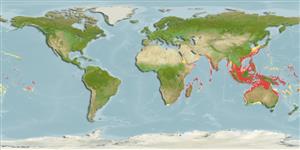Common names from other countries
Environment: milieu / climate zone / depth range / distribution range
Ökologie
seewasser; brackwasser demersal; tiefenbereich 10 - 110 m (Ref. 12260). Tropical; 26°C - 29°C; 35°N - 36°S, 19°E - 137°W
Indo-Pacific: Red Sea and the east African coast (30° to about 50°S) to Australia and Tahiti, north to the Ryukyu Islands (Ref. 27956).
Size / Gewicht / Alter
Maturity: Lm ? range ? - ? cm
Max length : 21.0 cm FL Männchen/unbestimmt; (Ref. 5525); common length : 15.0 cm TL Männchen/unbestimmt; (Ref. 5450)
Rückenflossenstacheln (insgesamt) : 8; Rückenflossenweichstrahlen (insgesamt) : 15 - 17; Afterflossenstacheln: 3; Afterflossenweichstrahlen: 13 - 14.
Found in shallow inshore coastal waters over silty bottoms (Ref. 30573, 90102). Young enters mangrove estuaries or silty reef areas (Ref. 4833, 90102). Searches for prey using a protruding pipette-like mouth or by sieving potential food through their gill rakers (Ref. 26569). Feeds on small fishes, shrimps, other crustaceans, and polychaetes. Sold fresh and dried salted; also made into fishmeal.
Life cycle and mating behavior
Maturities | Fortpflanzung | Spawnings | Egg(s) | Fecundities | Larven
James, P.S.B.R., 1984. Leiognathidae. In W. Fischer and G. Bianchi (eds.) FAO species identification sheets for fishery purposes. Western Indian Ocean (Fishing Area 51). Vol. 2. FAO, Rome. pag. var. (Ref. 3424)
IUCN Rote Liste Status (Ref. 130435)
CITES (Ref. 128078)
Not Evaluated
Bedrohung für Menschen
Harmless
Nutzung durch Menschen
Fischereien: kommerziell
Tools
Zusatzinformationen
Download XML
Internet Quellen
Estimates based on models
Preferred temperature (Ref.
115969): 24.5 - 29, mean 27.9 (based on 1548 cells).
Phylogenetic diversity index (Ref.
82804): PD
50 = 0.5312 [Uniqueness, from 0.5 = low to 2.0 = high].
Bayesian length-weight: a=0.01549 (0.01184 - 0.02026), b=3.05 (2.98 - 3.12), in cm Total Length, based on LWR estimates for this species (Ref.
93245).
Trophic level (Ref.
69278): 4.2 ±0.0 se; based on diet studies.
Widerstandsfähigkeit (Ref.
120179): hoch, Verdopplung der Population dauert weniger als 15 Monate. (K=0.70-1.30).
Fishing Vulnerability (Ref.
59153): Low vulnerability (14 of 100).
